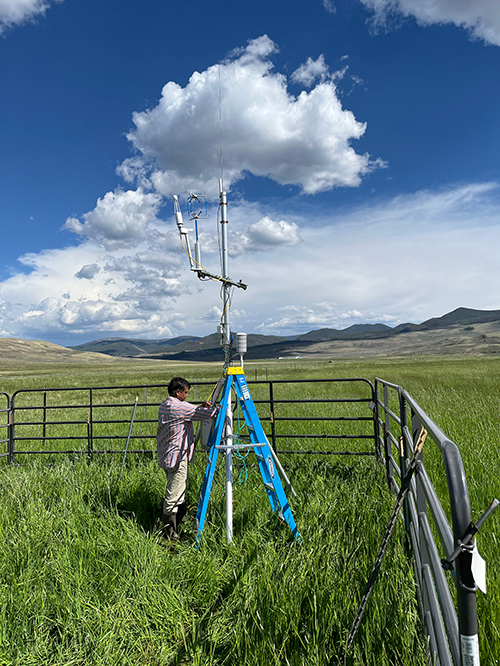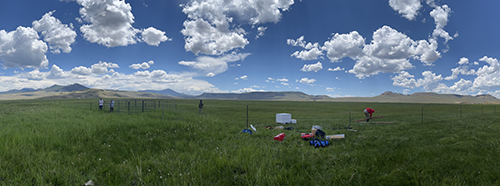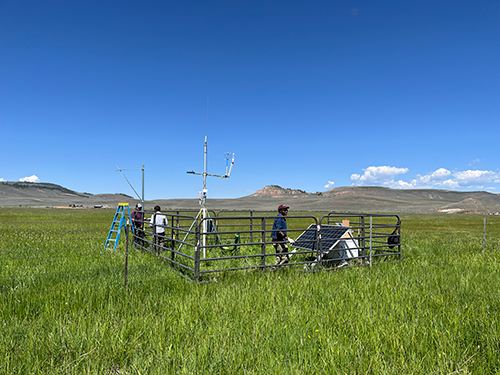 EC station is installed outside Gunnison, CO
EC station is installed outside Gunnison, CO
Federal funding for Drought Contingency Plan-related activities in the Upper Colorado Basin is coming to fruition. The initial $8.7 million investment announced under the Bipartisan Infrastructure Law in July 2023 was earmarked for the purchase and installation of 10 new eddy covariance (EC) stations in the upper basin and installation of those stations will soon be complete.
Eddy covariance stations play a crucial role in measuring evapotranspiration rates within the basin. Evapotranspiration is defined as the combined process of water loss through soil evaporation and plant transpiration, and is influenced by factors such as solar radiation, atmospheric vapor pressure, temperature, and wind and soil moisture levels.
Reclamation and the Upper Basin states, along with other partners, studied evapotranspiration in the basin from 2018 through 2020, using the basin’s four original EC stations. The ground-truth data that was collected and analyzed provided critical insight and demonstrated the need and value of expanding the methodology.
“Our methodology has to keep up with science,” said Research and Modeling Group Chief James Prairie. “The eddy covariance stations provide sound, transparent data for water users in the basin.”
So far, a total of eight new EC stations have been installed in Colorado, New Mexico and Wyoming; and an additional two stations are slated to be installed and operational in Utah by the end of August. Working with the Upper Colorado River Commission, Reclamation contracted the installation of the EC stations to the Daughtry Water for Food Institution at the University of Nebraska-Lincoln in Nebraska.

Each station is contained in a fenced off area that is approximately 20 feet by 20 feet and takes around 2 days to install. These 10-feet-tall instruments stay in the field over the growing season and are removed at the end of the fall and stored for the winter season. Each station will be reinstalled the following spring.
Understanding and quantifying evapotranspiration is vital for effective water management strategies. By accurately measuring these rates, researchers can identify which crops have the highest water consumption rates, enabling more precise planning for irrigation needs.
EC stations in the Upper Colorado Basin are proving to be pivotal not only for assessing evapotranspiration rates but also for confirming the accuracy of past evapotranspiration estimates made by Reclamation’s Research and Modeling Group in the UCB. Since their installation, these stations have consistently validated the previous year’s water use estimates generated by our modeling experts. This validation reinforces the reliability and effectiveness of our evapotranspiration estimation tools in managing water resources across the region and allows the RMG to continue working with the academic and scientific communities to continually advance methods that estimate evapotranspiration on a basin-wide scale.

“Further expanding our EC tower ground-truthing network allows the Upper Colorado River Basin to foster continued advancements in satellite based consumptive use estimation, ensuring accuracy improvements can continually be included when measuring irrigated agriculture’s consumptive uses, the Upper Basin’s largest water use sector,” said Prairie.
The deployment of these EC stations aligns with drought contingency planning efforts and fulfills obligations under the Colorado River Drought Contingency Plan. These measures are aimed at bolstering the region's resilience against water scarcity and ensuring sustainable water use practices.
The expansion of the EC station network underscores a proactive approach towards addressing water resource challenges in the Upper Colorado Basin, leveraging advanced scientific tools to inform decision-making and support agricultural and environmental sustainability.

